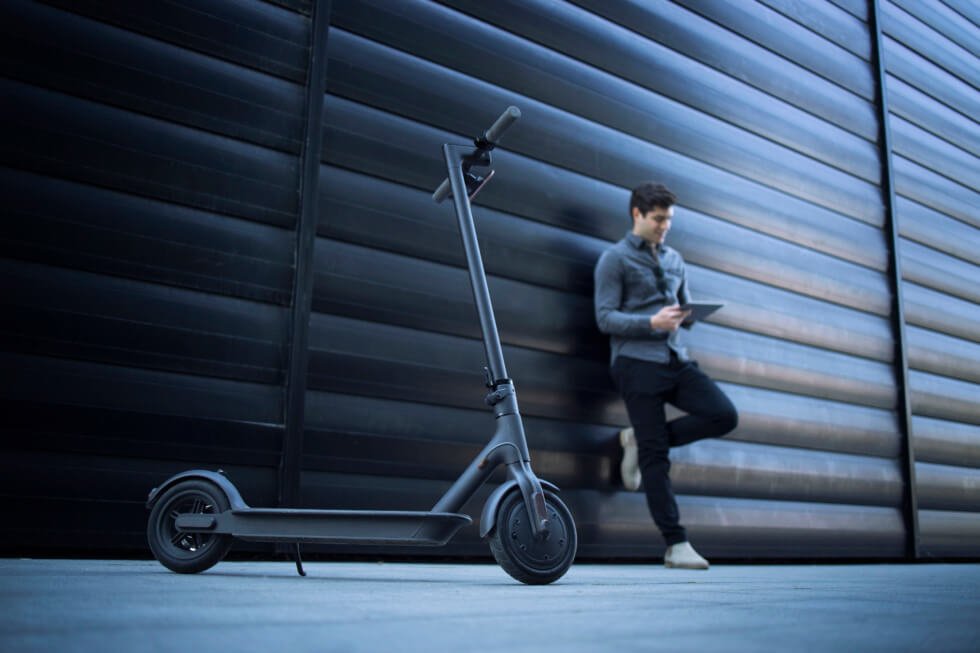Electric scooters are just the perfect thing to fill a very specific niche of urban transportation.
Not everyone wants to cycle around town (too much work/too hilly/too sweaty), riding public transportation can be time-consuming, and some cities are just too chaotic to safely drive.
But with a scooter, you can zip around at will—either a few blocks to hit up that new bar or brunch joint you’ve heard about, or all the way across town to meet up with friends or check out some epic new exhibit.
Really, electric scooters have and continue to change the urban transportation game.
So it’s no surprise that manufacturers are constantly putting out newer, better, and faster models every year.
Right now, we’ve got access to scooters that can drive nearly as fast as our cars, as well as slower models for those who prefer safety over speed.
Below, we’ve collected a list of the (current) fastest electric scooters available to you. Take note: these are the models on sale today—who knows, tomorrow may feature a faster, sleeker, more efficient model? But that’s half the fun of rapidly advancing technology!
Check out this list of the fastest electric scooters, and read through our Buying Guide and FAQs below to learn everything you need to know about choosing—and using—a lightning-fast electric scooter.
FASTEST ELECTRIC SCOOTERS
Contents
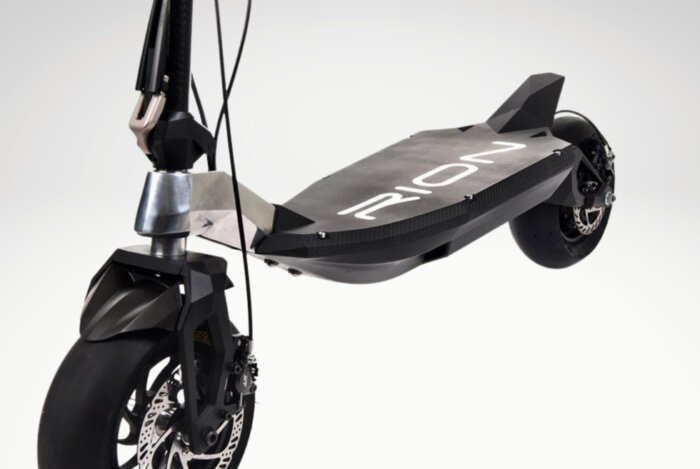
Fastest Electric Scooter in The World: Rion 2RE70 Thrust
The Rion 2RE70 Thrust currently holds the title as the fastest electric scooter in the world by a sizeable margin. It can go at least 80 MPH (more, depending on rider weight, battery charge, terrain, etc.) and lasts for up to 50 miles on a single charge of the 30 ah/84V lithium battery.
It’s built for durability as well as speed: a carbon fiber front fender, body, pole, and handlebars, as well as sub aluminum front and rear arms. The PMT Slick racing tires enable it to reach top-in-class speeds with maximum traction to keep you safe even on slippery or debris-covered roads. It’s a bit heavy at 69 pounds, but you want all that extra weight to maintain a low center of gravity while you’re zipping down sidewalks and around city streets!
Specs
- Top Speed: 80+ MPH
- Motor Power: Unspecified
- Weight: 69 lbs.
- Capacity: Unspecified
- Range: 45-50 miles per charge
- Charge Time: Unspecified
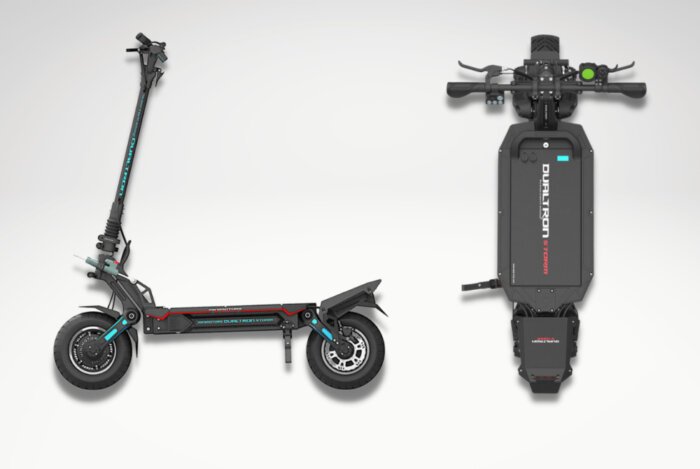
Dualtron Storm Limited
The Dualtron Storm Limited takes second place with an impressive top speed of 75 MPH, but a max range of 124 miles that is more than double what our top pick can manage. It can handle up to 265 pounds (rider + gear) and a climbing grade of up to 23 degrees, thanks to its high-power dual hub electric motor. It’s heavy—a whopping 111 pounds—but sturdy, stable, and built to last for years of daily use.
Charge time on the Dualtron Storm Limited varies: 21 hours with a 1.75A charger, 10 hours with two chargers, and 4.5 hours when using a standard charger with the (pricier) quick 6.5A charger.
The frame and handlebars are made using aviation grade 6082-T6 aluminum alloy, and the shaft is constructed from hyper-tough SCM440 steel. For maximum versatility, it features front and rear suspension, 12-inch RSC tubeless tires, and a Nutt Hydraulic Braking System with ABS Standard to give you serious stopping power. It also costs about 40% less than our #1 pick!
Specs
- Top Speed: 75 MPH
- Motor Power: 11500W
- Weight: 111 lbs.
- Capacity: 265 lbs.
- Range: 124 miles per charge
- Charge Time: 4.5-21 hours (depending on charger)

Weped FS
This beast of an electric scooter is built to go FAST. It’s literally HALF an MPH slower than our #2 pick, but it’s got a heck of a lot more power in the 30,000-watt motor—perfect for tackling hilly cities and uneven terrain.
The battery is an 72V 50AH Samsung SDI, one of the best lithium batteries on the market, so it’s no surprise that the scooter can manage up to 80 miles before needing a recharge. Like the Weped FF and SST, it features front and rear spring suspension, front and rear hydraulic disc brakes, and 11-inch PMT tubeless tires.
Standard charge time is 16 to 17 hours, though there is a fast-charge option available that will top up the battery in around 7 hours. However, take note: it’s a limited edition product that is ONLY made to order, so you’ll have to purchase directly from the manufacturer and expect a long wait time.
Specs
- Top Speed: 74.5 MPH
- Motor Power: 30,000W
- Weight: 121 lbs.
- Capacity: Unspecified
- Range: 80 miles
- Charge Time: Unspecified

BRONCO XTREME 11 SPORT
This sleek little electric scooter packs an impressive amount of power for an electric scooter. With an 80-mile range off of just one charge, it’s capable of carrying up to 265 pounds (of rider and gear) and charges in just 7 hours (with a 5A charger, purchased separately). It’s even capable of handling inclines up to 35 degrees, making it perfect for hilly cities like San Francisco.
The scooter runs on extra-wide 11-inch CST Urban Tires, solid wheels that can handle even gravelly and wet terrain adeptly. The body is made using a mixture of polypropylene, 6061-T6 Aviation Aluminium Forging Alloy, and carbon fiber that is incredibly tough and able to withstand impacts and accidents. Thanks to its adjustable coil suspension, air suspension, and copper graphite self-lubricating bearings, it’s a truly comfortable and safe ride anywhere you take it.
On the built-in LCD Intelligent Display, you can see your battery level, odometer, run-time, speed display, and trip metrics all at a glance. Now that’s an electric scooter you can love!
Specs
- Top Speed: 70 MPH
- Motor Power: 8400W
- Weight: 105 lbs.
- Capacity: 265 lbs.
- Range: 80 miles
- Charge Time: 7-20 hours

Dualtron X2 UP
Some might argue that this scooter goes the PERFECT speed: 69 MPH! You’ll find it’s incredibly comfortable to ride at top speeds, or to enjoy a slower-paced trip around town. Thanks to its industry-leading weight capacity—a whopping 330 pounds—even heavier riders will have no trouble carrying all the gear they need in their day.
The range is far above-average, too, and the charge time is superior to many of the slower-charging scooters on our list. The 13-inch tires are larger than most of its competitors and give you better traction and stability on the road, and the dual hydraulic suspension will give you enough impact-absorption that you’ll barely feel the bumps and potholes.
It’s a bit heavier than most of the other electric scooters on the list, meaning you’ll have to park it rather than fold and carry it in your backpack. But you’ll find it folds down nice and small so it won’t take up too much space in your garage when charging overnight.
Specs
- Top Speed: 69 MPH
- Motor Power: Dual 4150W motors
- Weight: 145 lbs.
- Capacity: 330 lbs.
- Range: 91 miles
- Charge Time: 8 hours
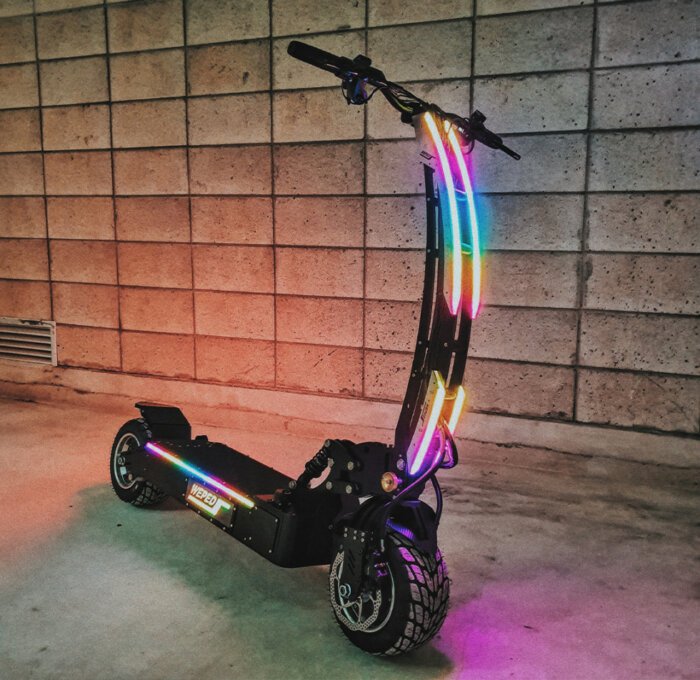
Weped SST
It may not be the speediest of the electric scooters on our list, but it’s definitely one of the most user-friendly. First of all, when connected to the 11A rapid charger, it tops up to 80% in roughly three hours—far faster than many of its competitors. It can hit cruising speeds of 65+ MPH, meaning on full charge and carrying a lighter rider, it can get in a few extra MPH to really max out the speed. And, under optimal conditions with a light rider, you may be able to eke out more than the “average” 80 mile range.
The SST is built with Weped’s largest battery packs (more than 10% bigger than the Dualtrons), giving you plenty of extra “zip” when you want to go faster for longer. The scooter operates twin 2X 100A controllers, which can generate up to 30KW of power—now that’s some serious oomph.
The tires are a bit smaller than average (just 10 inches), but they’re premium-grade and tubeless, meaning more durable. The hydraulic brakes include “regenerative braking” that engages the motor to slow you down, decreasing brake and tire wear. All in all, it’s a next-level electric scooter that you’ll love from the moment you set it in motion.
Specs
- Top Speed: 65+ MPH
- Motor Power: 30,000W
- Weight: 115 lbs.
- Capacity: 300 lbs.
- Range: 80+ miles
- Charge Time: 3+ hours

Kaabo Wolf King Plus
The Kaabo Wolf Plus may not be the fastest electric scooter on our list, but no one can argue that it isn’t one of the best. It’s capable of tackling up to 50 degree inclines, goes from 0 to 50 in 4.8 seconds, and gives you all the power you need to zip around town all day long, thanks to its 70-mile range.
Users who want a wider, safer ride will love the oversized deck, which gives you extra room to stand comfortably no matter what your preferred stance. It’s also got a higher-than-average ground clearance, perfect for getting over those potholes, obstacles in the road, or occasional speed bumps. Thanks to the powerful hydraulic braking system, you’ll rarely have to change your brakes while still counting on impressive stopping power.
The front hydraulic shock and rear spring suspension make this a safer, more comfortable ride, and you’ll find the 11-inch tubes supremely grippy even on wet surfaces. And, in case you’re worried about the rain, you can rest easy that the scooter is fully waterproof with its IPX5 rating.
Specs
- Top Speed: 62 MPH
- Motor Power: 2000W
- Weight: 115 lbs.
- Capacity: 330 lbs.
- Range: 70 miles
- Charge Time: 7 hours
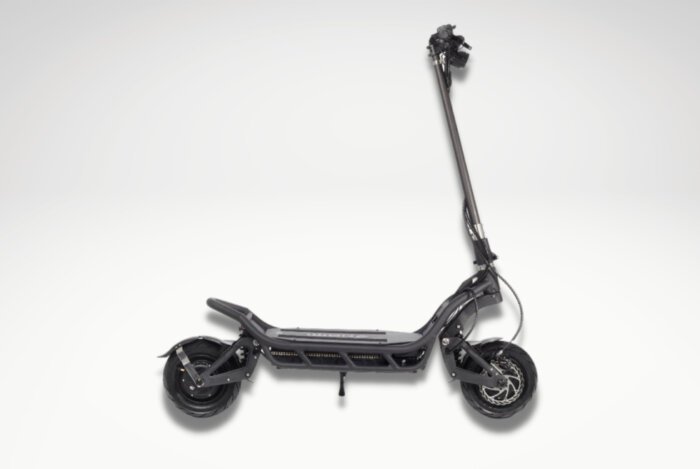
NAMI BURN-E 2 MAX
Whether you want to enjoy a slow, sedentary scoot through town or zip around at top speeds, the NAMI Burn-E 2 Max is an awesome choice. You can start up at walking speed or let it rip to hit 25 MPH in just 3 seconds. With dual 1500W motors, it packs a surprising amount of power despite its small size.
Don’t let the size fool you, though. It’s a solidly built, well-crafted piece of heavy-duty electronics that will last for years of daily use. The body is made using a carbon fiber steering column, a one-piece aluminum frame, and stainless steel parts that have been polished to a mirror sheen. The extra-tall handlebars are perfect for taller-than-average riders, or for hours-long rides.
Charge time on this scooter is above-average, too: with the provided 5A charger, you’ll top it up in 7-8 hours, but you can double-time it with the fast charger and get it back to 100% in just 3-4 hours. The color display is rich in features and makes all your trip data easy to see at a glance, even in low-light conditions. And you won’t find a lighting package better than the 2000-lumen LED headlights and lateral LED strips!
Specs
- Top Speed: 60 MPH
- Motor Power: Dual 1500W motors
- Weight: 103 lbs.
- Capacity: 330 lbs.
- Range: 90 miles
- Charge Time: 3-8 hours

ZERO 11X
The Zero 11X is the latest-and-greatest the brand has to offer, a model that’s taken everything users loved about the 10X and one-upped it impressively. The dual 1600W motors pack a powerful punch (max power of 5600W) and help you hit those top speeds of 60 MPH at lightning speed, or give you enough torque to muscle your way up steep hills or through muddy terrain.
It’s got a great weight capacity (330 lbs.), above-average range (90 miles), and is sturdy enough that you’ll feel confident taking it on or off-road. Everything from its braking capacity to its acceleration has been upgraded off its older models, making it a “beast” of a scooter that can stand neck and neck with the rest of the fastest electric scooters in the world.
Specs
- Top Speed: 60 MPH
- Motor Power: Dual 1600W motors
- Weight: 131 lbs.
- Capacity: 330 lbs.
- Range: 90 miles
- Charge Time: Unspecified
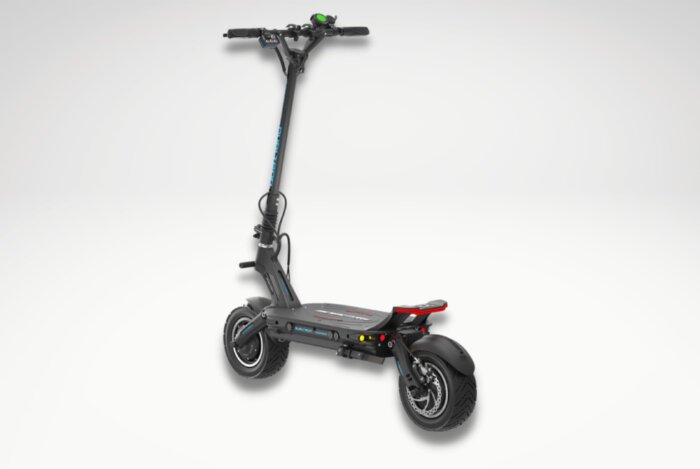
Minimotors Dualtron Thunder 2
Looking for a truly tough-and-rugged scooter capable of handling anything you can throw at it? Give this bad boy a closer look! It may not be the fastest, but it’s certainly built to last.
The body is made using aviation grade 6082-T6 aluminum alloy, as are the handles. With a SCM440 steel shaft and hyper-tough plastic covers, it’s a truly durable little machine. Thanks to its BLDC dual hub motors, which can generate over 10KW of power, you can tackle inclines up to 35 degrees.
The scooter comes with built-in hydraulic brakes, as well as ABS standard, though no suspension. The range is well above average—a whopping 107 miles on a single charge—and charge time is an impressive 6 hours when connected to the quick charger (sold separately). Best of all, you can add on nifty features like a damper, light mount, and seat to take your scooter to the next level.
Specs
- Top Speed: 55+ MPH
- Motor Power: 10,080W
- Weight: 105 lbs.
- Capacity: 265 lbs.
- Range: 107 miles
- Charge Time: 6-28 hours
BUYING GUIDE & FAQ'S
Let’s be honest: we’ve all spent hours zipping around the park, school ground, or even college campus on a scooter. Light, compact, and efficient, they’re an awesome form of transportation that just WORKS!
Electric scooters take things to the next level. By adding in motors, brakes, hydraulic suspension, lithium battery, and headlights, they’ve gone street-legal and give you the power to cover truly impressive distances at speeds your old childhood-days scooter never could.
Sure, they’re expensive—none of the scooters on our list retail for under $4,000—but it’s a luxury well-worth owning if you live and work in a city where it just doesn’t make sense to own a car and you don’t want to ride public transport.
Below, we’ll take a closer look at everything you need to know about buying and operating an electric scooter. By the end of this Buying Guide, you’ll be ready to choose one for your very own.
Factors that Affect E-Scooter Top Speeds
One thing you’ll often notice when researching the fastest electric scooter is a “+” on the speed rating.
For example, the fastest scooter on the market, the Rion Thrust, has a speed rating of 80+ MPH. What that means is that under the “ideal” conditions, the scooter is capable of hitting and possibly exceeding 80 MPH.
So what makes the “ideal” conditions and affects the electric scooters’ top speeds?
Weight
It goes without saying that the heavier the load, the slower the ride. Heavier loads demand more power, especially on inclines, so they drain the battery faster. The scooter will have a harder time reaching—as well as maintaining—top speeds. You’ll find this same problem with every vehicle: your car, truck, RV, or boat.
Typically, a high-weight load (heavier riders, or riders + lots of gear) will stop the scooter from hitting or exceeding its top speed. It’s not an issue with the scooter, just a factor to be aware of.
Terrain
When testing for the scooters’ top speeds, manufacturers typically use long, straight, pristine tracks (like race tracks) designed specifically to max out speed.
In real life, however, it’s much harder to find those “perfect” conditions. You’ve got to deal with traffic, stoplights and stop signs, uneven roads, gravel, debris, inclines and declines, poor road conditions, potholes, mud, rain, snow, and so many other things that will prevent you from letting it rip at full capacity.
Rough or uneven terrain will stop you from reaching your top speed.
Tires
As with any other vehicle, the condition and quality of your tires will have direct impact on your speed.
Tires propel you forward by pushing off the road beneath you (friction). The higher the friction, the more push, and the faster you go.
Good-quality tires built for speed will not only help you read your top MPH more quickly, but also keep you safer when running at high speeds. They’re designed for maximum traction with the road, so you’ll be less likely to slip or slide around even under wet conditions.
Battery Life
The more power available in the battery, the more power can be committed to running the motors at top capacity. As the battery drains, less power is available to run the motors, so your speed will inevitably slow.
Slower-than-max speed is actually a sign that your scooter is running out of juice and needs to be recharged.
(Note: Some e-scooters will keep running at “standard road speed” (18-25 MPH) right up until their battery hits that last 2-5%, while others will diminish in power as the battery drains. It’s worth reading reviews to see how well your scooter can run in low-power mode—if it sputters and putters around or can maintain decent speeds.)
A Word of Warning About E-Scooter Top Speeds
The scooter “top speed” rating is always a cool feature to look at, but take note: when operating your scooter in a U.S. or Canadian city, you will never be legally allowed to hit top speeds.
The laws will vary from state to state (or, for Canadians, province to province), but electric scooters are considered “regulated motorized personal mobility device” that cannot be ridden on sidewalk and can only be ridden on certain roads.
E-scooters manufactured to be ridden in urban or suburban environments are built with governors, mechanical devices that regulate their operating speed. (Cars have governors, too, which prevent them from ever reaching the “top speed” displayed on their odometer.) Legally, when operating in urban areas, the governors cannot be removed. You’ll have to run the scooter well away from your city—such as on a rural road or county highway—if you want to let it rip at top speeds with the governor removed.
Typically, electric scooters will run between 15 and 25 MPH when used in the city. That’s still a decent speed for motoring around town, but it’s safer for operating around pedestrians, cyclists, vehicles, and other scooters.
Factors to Consider When Buying an Electric Scooter
If you’re e-scooter shopping, you’ve always got to look “under the hood”. That means looking beyond just the sleek lines, fancy LED headlights and side-lighting, and cool-sounding names to find the scooter with the right specs.
Commuter vs. Performance
A commuter scooter is designed to be compact, foldable, and carried around (in a backpack, typically) when you’ve got to jump on/off buses, climb stairs to get onto the subway, or get in a taxicab. Commuter scooters are typically used in crowded urban areas where you can’t safely reach very high speeds, so they’ll have far less power but still offer a motorized form of transportation to make tackling hills easier.
A performance scooter, on the other hand, is designed for top speeds, typically used in wide-open areas and on highways and county roads. They maximize performance and power, and they cost far more than the budget-friendly commuter scooters. They’re also far too heavy to carry and too large to fold down.
As you no doubt guessed, all of the scooters in our list are performance scooters built for high power and top speeds. If you’re looking for a lightweight, compact, budget-friendly option, you’ll want to research the best commuter scooters.
Speed vs. Power
Speed is the “vanity metric” most people tend to look at when shopping for an electric scooter. There’s this mistaken belief that the faster the scooter, the more powerful, and thus the better. That’s not entirely true!
Take a look at some of the scooters on our list above, and you’ll see that some of the slower models actually pack more power in the motor. For example, the Dualtron Storm Limited can hit speeds of 75 MPH, but the Weped SST can only hit 65 MPH. On the other hand, the Weped SST has a motor that generates 30,000 watts of power, compared to the 11,500 watts of the Dualtron Storm Limited.
Consider the Bronco Xtreme, which can tackle inclines up to 35 degrees, or the Kaabo Wolf King, which can handle up to 50 degrees. Neither of them are the FASTEST on our list, but they pack some serious motor power and torque.
Power is often more important to consider than an electric scooter’s top speed, especially if you intend to run it in a city with steep hills—or even off-road on a terrain park.
Range
Range is a very critical factor to consider!
Think about it: if the scooter’s range is average at best, you’ll have to charge it far more often than a scooter with a very high range. For example, the Rion Thrust gets impressive top speeds (best-in-class), but if you have to recharge it every 45 to 50 miles, that means you get far less use out of it between charges than a slower model with a much higher range—such as the Minimotors Dualtron Thunder 2 with its 107-mile range.
And what good is a hyper-fast scooter if it runs out of power when you’re halfway to work or almost at your destination? Without a charge, it’s just an ultra-heavy weight you’ll have to push until you reach a charging station.
Consider how far you have to drive each day/week, and how much you intend to use it. If you’re a short-range driver, you can easily charge every night when you get home without too much inconvenience. But if you plan to use it regularly and travel greater distances, you’ll want to find a scooter with a longer range.
Weight
While commuter e-scooters are designed to fold down and fit in a backpack, the high-powered, top-speed beasts on our list weigh anywhere from 60 to 120 pounds—far too heavy for the average person to lift. You’ll depend on the power of the motor to get around.
But you won’t always have the scooter running under its own power; sometimes you’ll need to push it (into its charging station or the rack where it’ll be parked). If it’s too heavy for you to push, it will just tire you out and be an annoying inconvenience.
However, bear in mind: a heavier scooter will often be more stable and less prone to accidents than a lightweight scooter, because there is more weight keeping your center of gravity low (close to the street). You have to consider if the extra stability/safety is worth the added weight, or if you’d rather keep it light and easily moveable.
Weight Capacity
Do you know how much weight you carry around on a daily basis? You’ve got not only your body weight, but also the weight of your clothes, shoes, accessories, and whatever you’re carrying around in your bag, backpack, or briefcase. All of that adds up—so you’ve got to make sure your scooter can handle it.
Thankfully, most scooters have a pretty high weight capacity: anywhere from 265 to 330 pounds for the scooters on our list. For the average person, it’ll be easy to stay within a safe weight limit.
But what about extra-tall and extra-heavy users? Or what about people who carry heavy backpacks or bags filled with equipment or electronics? That’s when things can get a bit tricky!
Make sure to check the maximum weight capacity when shopping for a scooter. Consider how much you weigh, and how much additional weight you will carry around on both a daily and occasional basis. You want to be certain your scooter can handle all the extra weight safely without straining the motor or draining the power too quickly.
Durability
Durability is a critical factor for any form of transportation: boat, car, truck, RV, bicycle, and, of course, scooter. Perhaps even more so for scooters because there are no solid frames to protect it from damage in case of a crash or collision!
Typically, scooter bodies are made from super-tough materials like steel, aircraft grade aluminum, and carbon fiber plastics that can take a real beating. Some of the smaller “façade” components will be made using cheaper plastics (like polypropylene), but those components won’t affect how well the scooter can withstand impacts or crashes.
Pay attention to the product reviews and look for any complaints that the scooter you’re considering isn’t durable. If parts bend, crack, or break off easily, it’s a sign to look elsewhere for a better-quality option.
Safety
Two things affect safety:
- The quality of the materials used to build the scooter. You always want high-grade steels, aircraft grade aluminum, premium carbon fiber plastics, and other tough-and-rugged materials that will withstand impacts.
- Built-in safety features, such as brakes, suspension systems, high-visibility lights (so fellow vehicles can see you), headlights (so you can see the road ahead), and a design that enhances stability.
If it doesn’t come with sufficient safety features, it’s not worth considering!
Price
Commuter scooters are typically inexpensive, but performance scooters (like the ones on our list) will cost you a pretty penny—anywhere from $3,000 to $12,000, easily.
When shopping performance scooters, price isn’t the most important factor to consider, but it is something to keep in mind. Just because a scooter is expensive doesn’t mean it’s top-of-the-line or the best quality.
My recommendation: find a scooter that fits your safety, reliability, and performance criteria first, and your budget second.
FAQs
Are electric scooters safe?
Asking if electric scooters are safe is like asking “Are racecars safe?” or “Are razor-sharp kitchen knives safe?” The answer will always be: depends on who is using it and how it’s used.
If you’re a safety-minded operator who follows the speed limits, wears the recommended protective gear, obeys signs and signals, is conscious of traffic and pedestrians, and takes precautions to remain safe while driving, you should have nothing to worry about. But if you’re a reckless driver who speeds, ignores traffic laws and signs, and refuses to wear protective gear, then no, electric scooters are far from safe.
Are electric scooters road-legal?
According to the good people at YourLawyer: “Electric scooters are street-legal in 38 of the U.S. states, while another ten states have deemed them to not be street-legal. While electric scooters are street-legal in a majority of the states, some state have applied additional laws to where and how scooters can be operated while on public roadways. Four states, California, Colorado, Massachusetts, and New York, do not allow scooters on highways, expressways, or limited-access roads due to most scooters not being able to reach safe enough speeds to keep up with the traffic. Massachusetts, Connecticut, Indiana, Maine, and Virginia have added the stipulation that while scooters are street-legal, they must stay to the right side of the road while being ridden.”
Unagi Scooters has a great graphic showing the laws and legalities of riding e-scooters within the US.
In Canada, electric scooters are only legal in Ontario and Quebec, but not in the other Canadian provinces.
In the UK, “It is illegal to use a privately owned e-scooter on pavements, cycle paths or roads at present. Under current UK law, e-scooters are classed as ‘powered transporters’ and as such are treated in the same way as motor vehicles, so pavements and cycle paths are strictly off limits.” (Source: WhatCar)
Do I need to wear safety gear when riding an e-scooter?
Absolutely! A helmet can protect your head against critical, life-threatening injuries, and you’re legally required to wear one at all times when operating a motorized vehicle.
You should also consider wearing:
- Gloves (like motorbiker gloves) to protect your hands
- Elbow and knee pads to protect your very breakable joints
- A Kevlar hoodie to protect your upper body in case of a fall
- Sturdy shoes that won’t rip or tear if you fall off your scooter at high speeds
- Motorcycle or racing pants, or, at the very least, sturdy jeans


